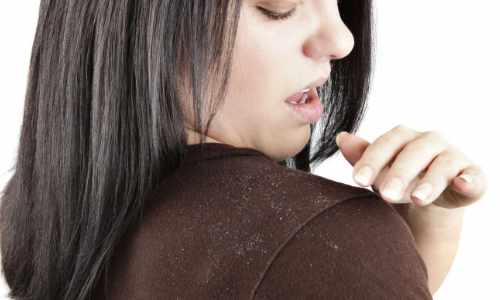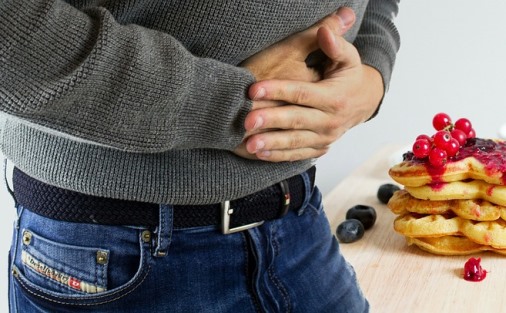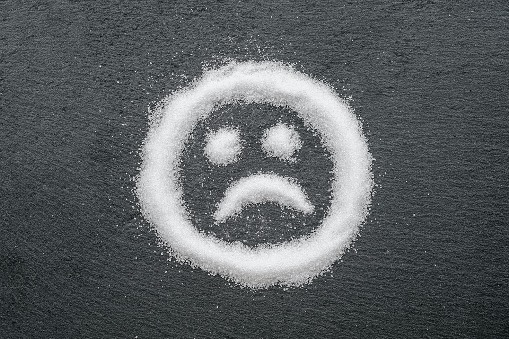DANDRUFF - AN OVERVIEW
Dandruff is a common scalp condition characterized by the presence of small, white flakes of dead skin that often appear in the hair and on clothing. While it is a harmless and non-contagious condition, it can be a source of embarrassment and discomfort for those affected. Dandruff is primarily caused by the excessive shedding of dead skin cells from the scalp, leading to their accumulation on the hair and shoulders.
Managing dandruff often involves regular and gentle cleansing of the scalp using anti-dandruff shampoos. These shampoos typically contain active ingredients like zinc pyrithione, ketoconazole, selenium sulfide, or salicylic acid, which help control the growth of Malassezia and reduce skin cell turnover. Maintaining good scalp hygiene, avoiding excessive use of styling products, and managing stress can also contribute to dandruff prevention.
It’s essential to note that dandruff is a chronic condition, and while it can be controlled with appropriate care, it may recur. Consulting with a healthcare professional or dermatologist can provide personalized advice and treatment options for individuals dealing with persistent or severe dandruff issues.
SYMPTOMS OF DANDRUFF
Dandruff presents itself through various symptoms, and its manifestation can vary from person to person. The most common symptoms include:
White or Yellow Flakes: The hallmark sign of dandruff is the presence of small, white or yellowish flakes on the scalp, hair, and clothing. These flakes may range in size and can be easily noticeable, especially on dark clothing.
Itching: Many individuals with dandruff experience itching of the scalp. Scratching the scalp can exacerbate the condition and may lead to redness and inflammation.
Dry Scalp: Dandruff is often associated with dry skin on the scalp. Dryness can cause the skin to flake more easily, contributing to the formation of dandruff.
Oily or Greasy Scalp: While dryness is a common symptom, some people with dandruff may have an oily or greasy scalp. This can be particularly true in cases where dandruff is associated with conditions like seborrheic dermatitis.
Redness and Irritation: In more severe cases, dandruff may be accompanied by redness and irritation of the scalp. This can be indicative of underlying inflammation or other skin conditions.
Presence of Scalp Sores: In cases where dandruff is associated with seborrheic dermatitis, there may be the formation of crusty or oily scalp sores.
CAUSES OF DANDRUFF
Understanding the specific factors that contribute to an individual’s dandruff is crucial for effective management. It’s important to note that dandruff is a chronic condition, and while it can be controlled, it may require ongoing care. Dandruff can be caused by various factors, and its development is often influenced by a combination of these factors. The primary causes include:
Malassezia Overgrowth: The most common cause of dandruff is the overgrowth of a yeast-like fungus called Malassezia on the scalp. This fungus is naturally present on the skin but can lead to increased skin cell turnover and dandruff when it proliferates.
Dry Skin: Dry skin on the scalp can result in smaller, easily shed skin flakes. Lack of moisture can be influenced by factors such as cold weather, indoor heating, and frequent shampooing.
Seborrheic Dermatitis: This is a more severe form of dandruff characterized by red, inflamed skin and stubborn, larger flakes. Seborrheic dermatitis is thought to be related to an overreaction to the presence of Malassezia, coupled with factors like stress and hormonal changes.
Not Enough Shampooing: Infrequent or inadequate shampooing can lead to the accumulation of dead skin cells and oils on the scalp, contributing to dandruff.
Certain Hair Care Products: The use of hair care products that irritate the scalp or contain harsh chemicals can contribute to dandruff. Additionally, the frequent use of styling products may build up on the scalp and exacerbate the condition.
Hormonal Changes: Changes in hormonal levels, such as those occurring during puberty, pregnancy, or menstruation, can affect the production of skin oils and contribute to dandruff.
Diet and Nutrition: A diet lacking in certain nutrients, especially those essential for skin health, may contribute to dandruff. However, the relationship between diet and dandruff is not fully understood.
Stress: Emotional stress can impact various bodily functions, including the immune system and skin health. Stress may exacerbate existing dandruff or contribute to its development.
PREVENTION OF DANDRUFF
Preventing dandruff involves adopting good scalp hygiene practices and addressing potential contributing factors. Adapt to your hair care routine to your specific needs, and if you notice any changes or persistent issues, seek medical advice for a more personalized approach. Here are some preventive measures against Dandruff :
Regular Shampooing: Washing your hair regularly helps prevent the accumulation of dead skin cells, oils, and styling products on the scalp. Use a mild, anti-dandruff shampoo containing ingredients like zinc pyrithione, ketoconazole, selenium sulfide, or salicylic acid.
Proper Hair Care Products: Choose hair care products that are gentle on the scalp and avoid those containing harsh chemicals that may cause irritation. Be mindful of styling products and limit their use, as they can contribute to dandruff.
Maintain Scalp Moisture: Avoid excessive dryness or oiliness of the scalp. In dry conditions, use a humidifier to add moisture to the air. In contrast, if your scalp tends to be oily, consider using shampoos designed for oily hair.
Balanced Diet: Ensure a well-balanced diet rich in essential nutrients, as nutrition plays a role in overall skin health. Include foods with omega-3 fatty acids, zinc, and B vitamins.
Manage Stress: Practice stress management techniques, such as meditation, yoga, or deep breathing exercises. Stress reduction can have a positive impact on overall health, including the health of your skin and scalp.
Regular Exercise: Engaging in regular physical activity promotes good circulation, which is beneficial for overall skin health, including the scalp.
Avoid Hot Water: When washing your hair, use lukewarm water instead of hot water. Hot water can strip the scalp of its natural oils, leading to dryness and potential dandruff.
Sun Protection: If you spend a lot of time outdoors, protect your scalp from excessive sun exposure by wearing a hat. Sunburn can contribute to scalp dryness and irritation.
Check Your Hair Products: Ensure that the hair care products you use, including shampoos and conditioners, are suitable for your scalp type. If you notice any irritation, consider switching to gentler alternatives.
Regular Check-ups: If you have persistent or severe dandruff, consult with a dermatologist. They can provide a proper diagnosis and recommend a targeted treatment plan based on the underlying causes.
DIAGNOSIS OF DANDRUFF
Dandruff is typically diagnosed based on its characteristic symptoms and a physical examination of the scalp. In most cases, a healthcare professional, such as a dermatologist, can diagnose dandruff by visually inspecting the scalp for signs like white or yellowish flakes, redness, and inflammation. They may also inquire about the patient’s medical history, including any previous occurrences of dandruff, current symptoms, and factors that may influence the condition.
Dandruff is typically diagnosed based on its characteristic symptoms and a physical examination of the scalp. In most cases, a healthcare professional, such as a dermatologist, can diagnose dandruff by:
Clinical Examination: The healthcare provider will visually inspect the scalp to look for signs of dandruff, such as the presence of white or yellowish flakes, redness, and inflammation.
Medical History: The healthcare provider may ask about the patient’s medical history, including any previous occurrences of dandruff, current symptoms, and any factors that may exacerbate or alleviate the condition.
Scalp Analysis: In some cases, a dermatoscope may be used to examine the scalp more closely. This handheld instrument with a light source allows the healthcare professional to magnify and analyze the skin and hair follicles.
Rule Out Other Conditions: The healthcare provider may rule out other scalp conditions that can mimic the symptoms of dandruff, such as psoriasis, eczema, or fungal infections. This may involve additional tests or procedures, depending on the specific case.
In certain situations, where the diagnosis is unclear or if there are concerns about an underlying medical condition, the healthcare provider may recommend additional diagnostic tests, including:
Microscopic Examination: A microscopic examination of scalp scrapings can be performed to check for the presence of yeast or other microorganisms that may contribute to dandruff.
Skin Biopsy: In rare cases, a small sample of the scalp may be collected for a biopsy to rule out other skin conditions and determine the underlying cause of persistent or severe dandruff.
ALLOPATHY APPROACH TOWARDS DANDRUFF REATMENT
The allopathic approach toward dandruff treatment involves various methods to control the condition and alleviate symptoms:
Medicated Shampoos: Allopathic treatment often includes the use of specialized anti-dandruff shampoos. These shampoos may contain active ingredients such as zinc pyrithione, ketoconazole, selenium sulfide, or salicylic acid. Regular use of these shampoos helps to reduce the overgrowth of Malassezia, control inflammation, and manage flaking.
Topical Steroids: In cases where dandruff is associated with significant inflammation, topical steroids may be prescribed to reduce redness, itching, and inflammation of the scalp. However, long-term use of steroids is typically avoided due to potential side effects.
Antifungal Creams: For more severe cases or when dandruff is linked to conditions like seborrheic dermatitis, antifungal creams containing ingredients like ketoconazole may be recommended for application to the affected areas.
Prescription Medications: In certain situations, oral antifungal medications or antibiotics may be prescribed if dandruff is persistent and resistant to topical treatments. These medications are typically used for a limited duration under medical supervision.
Scalp Treatments: Some dermatologists may recommend in-office treatments, such as light therapy (phototherapy), to manage dandruff and associated scalp conditions. These treatments aim to regulate skin cell turnover and reduce inflammation.
AYURVEDA APPROACH TOWARDS DANDRUFF TREATMENT
In Ayurveda, dandruff is viewed as an imbalance in the doshas, particularly the Vata and Kapha doshas. The approach towards treating dandruff involves addressing this imbalance and promoting overall scalp health. Here are key principles in Ayurveda for dandruff treatment:
Dietary Recommendations: Ayurveda emphasizes a balanced diet to maintain overall health, including the health of the skin and scalp. Incorporating foods that pacify Vata and Kapha doshas, such as warm, nourishing, and easily digestible meals, is recommended.
Herbal Remedies: Ayurvedic herbs and natural ingredients are commonly used for dandruff treatment. Some examples include neem, amla (Indian gooseberry), fenugreek, tulsi (holy basil), and aloe vera. These herbs are known for their antimicrobial and soothing properties, which can help alleviate dandruff symptoms.
Ayurvedic Shampoos: Herbal shampoos containing Ayurvedic ingredients are recommended for dandruff. These may include extracts of neem, amla, shikakai, and other herbs known for their cleansing and conditioning properties.
Lifestyle Adjustments: Ayurveda emphasizes lifestyle practices that balance the doshas. This includes maintaining a regular sleep schedule, managing stress through practices like meditation and yoga, and staying hydrated.
Personalized Approach: Ayurveda recognizes that individuals have unique constitutions (Prakriti), and the treatment approach may vary accordingly. A consultation with an Ayurvedic practitioner can provide personalized recommendations based on one’s constitution and imbalances.
ROLE OF PANCHKARMA IN DANDRUFF TREATMENT
Panchakarma aims to balance the doshas (Vata, Pitta, and Kapha), remove accumulated toxins (ama), and restore harmony to the body and mind. Panchakarma can be a holistic approach to address imbalances in the body but, its effectiveness in dandruff treatment may vary from person to person. The selection of specific Panchakarma therapies depends on an individual’s constitution (Prakriti), the nature of the dosha imbalance, and the severity of the condition. Here’s how Panchakarma may contribute to dandruff treatment:
Detoxification: Panchakarma therapies help eliminate toxins from the body, including those that may contribute to imbalances in the doshas. This detoxification process is believed to purify the blood and tissues, addressing the root cause of dandruff.
Balancing Doshas: Panchakarma treatments are tailored to an individual’s dosha imbalance. By restoring balance, particularly in cases where Vata and Kapha doshas are involved, Panchakarma can help prevent the recurrence of dandruff.
Abhyanga (Oil Massage): Abhyanga, a key component of Panchakarma, involves therapeutic oil massage. This practice helps nourish the scalp, improve blood circulation, and reduce dryness, addressing one of the underlying causes of dandruff.
Shirodhara: Shirodhara is a Panchakarma therapy where a continuous stream of warm oil is poured onto the forehead. This treatment can have a calming effect on the nervous system, reducing stress, which is a potential contributor to dandruff.
Nasya (Nasal Therapy): Nasya involves the administration of herbal oils or medicated substances through the nasal passages. This therapy is believed to have a positive impact on the respiratory system and may contribute to overall scalp health.
Swedana (Steam Therapy): Steam therapy is often included in Panchakarma to induce sweating and open up the channels, promoting the elimination of toxins. This can be beneficial in cases where dandruff is associated with a buildup of impurities.
DANDRUFF TREATMENT AT DR MONGA MEDI CLINIC
At Dr Monga Medi Clinic, we treat patients suffering from Dandruff through our unique integrated approach of usring Allopathy and Ayurveda.
Our experts focus on balancing doshas with dietary adjustments, herbal remedies (neem, amla), scalp massages, and Ayurvedic shampoos. Lifestyle changes. In severe cases, Panchakarma procedures may be recommended along with allopathic medicines. Our treatment involves using medicated shampoos (zinc pyrithione, ketoconazole), prescription medications (antifungal, steroids), and scalp treatments (coal tar, calcineurin inhibitors).
Our integrated approach emphasizes regularly combining elements from both systems, based on individual preferences and efficacy.
FREQUENTLY ASKED QUESTIONS
While dandruff can be effectively managed, complete and permanent cure may not be guaranteed. Maintenance and lifestyle adjustments are often required.
Results vary, but consistent use of recommended treatments over a few weeks is often needed for noticeable improvement.
Consult a healthcare professional if home remedies or over-the-counter treatments do not alleviate dandruff or if symptoms worsen, as it could indicate an underlying condition.
Home remedies include regular shampooing with anti-dandruff shampoos, incorporating natural ingredients like tea tree oil or aloe vera, and maintaining good scalp hygiene.
INFORMATIVE ARTICLES ON HAIR AND SKIN PROBLEMS
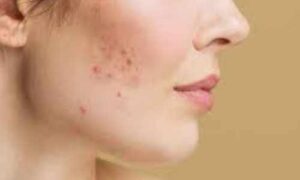
Acne and Pimples
ACNE AND PIMPLES – AN OVERVIEW Acne and pimples, two dreaded words for anyone who has ever dealt with them. These pesky little bumps can appear

Skin Allergies
SKIN ALLERGIES – AN OVERVIEW Skin allergies, or allergic dermatitis, result from exposure to allergens like foods, plants, metals, or medications. Symptoms include redness, itching,
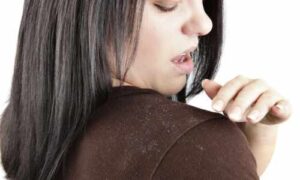
Dandruff
DANDRUFF – AN OVERVIEW Dandruff is a common scalp condition characterized by the presence of small, white flakes of dead skin that often appear in

